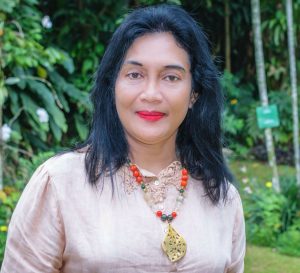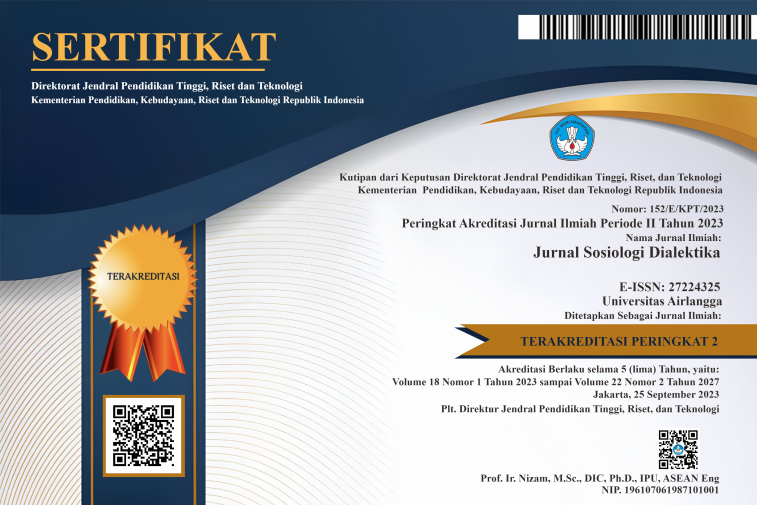Korean street food in contemporary Indonesia: Glocalization in a semi-medium city
Downloads
Korean street food in Indonesia is part of the ‘Korean Wave’ (hallyu) that hit Indonesia in the early 2010s. It is not difficult to find Korean street food in Indonesian cities. Korean street food has become part of urban culture in Indonesia. This research aims to analyze the existence of Korean street food in Indonesia using the concept of glocalization according to Roland Robertson. This research also analyze the glocalization of Korean street food in the local context in the form of halal Korean street food so that it is accepted and consumed by Indonesian people. This study uses a qualitative method with a case study approach as a research strategy. Data collection was carried out by means of observation, interviews, and documentation. The result of this study has shown that through various forms of glocalization, Korean street food has become part of Indonesian society. Korean street food has carried out relative syncretism of food through a process of particularization as universalization. This process is carried out by adopting the halal concept in Korean street food. The results of this research contribute to understanding the glocalization of street food in adopting the halal concept.
Abrahale K, Sousa S, Albuquerque G, Padrão P, & Lunet N (2019) Street food research worldwide: A scoping review. Journal of Human Nutrition and Dietetics 32 (2):152-174. https://doi.org/10.1111/jhn.12604.
Alfiero S, Giudice A, & Bonadonna A (2017) Street food and innovation: the food truck phenomenon. British Food Journal 119 (11):2462-2476. https://doi.org/10.1108/BFJ-03-2017-0179.
Alzeer J, Rieder U, & Hadeed AK (2020) Good agricultural practices and its compatibility with halal standards. Trends in Food Science & Technology 102: 237-241. https://doi.org/10.1016/j.tifs.2020.02.025.
Amin M, Zakaria Z, & Rahim A (2020) Halal certification of Korean Food in Malaysia: The challenges and steps ahead. The Journal of Muamalat and Islamic Finance Research 17 (2):61-74 https://doi.org/10.33102/jmifr.v17i2.294.
Andina A, Barokah S, & Satriawan T (2020) Cup sleeve event as a new form of hedonism for K-Pop fans. Probisnis 13 (1):23-33. http://dx.doi.org/10.35671/probisnis.v13i1.982.
Anggraini R, Februhartanty J, Bardosono S, Khusun H, & Worsley A (2016) Food store choice among urban slum women is associated with consumption of energy-dense food. Asia Pacific Journal of Public Health 28 (5):458-468. https://doi.org/10.1177/1010539516646849.
Azeharie S (2023) Cultural proximity of Korean and Indonesian in Korean Dramas. WACANA: Jurnal Ilmiah Ilmu Komunikasi 22 (1):131-141. https://doi.org/10.32509/wacana.v22i1.2440.
Azhar P (2023) Pengaruh harga, promosi, dan kualitas produk terhadap minat pembelian merchandise K-Pop official melalui e-commerce (Studi kasus pada penggemar K-Pop Army Space Purwokerto). Thesis, State Islam University Prof. KH Saifuddin Zuhri, Purwokerto.
Badan Pusat Statistik (BPS) Kabupaten Banyumas (2023) Banyumas Dalam Angka 2022. Purwokerto: BPS Banyumas.
Caldito R, Candano D, & Diaz K (2022) The impact of brand equity of Korean barbeque restaurants on purchase decision among Generation-Z in Metro Manila. Journal of Business and Management Studies 4 (1):115-123. https://doi.org/10.32996/jbms.2022.4.1.14.
Calloni M (2013) Street food on the move: A socio‐philosophical approach. Journal of the Science of Food and Agriculture 93 (14):3406-3413. https://doi.org/10.1002/jsfa.6353.
Chee JW & Yazdanifard R (2021) The influence of customer perception in selection of Korean Restaurant in Malaysia. International Journal of Management, Accounting & Economics 8 (2). https://doi.org/10.5281/zenodo.4641400.
Choo HJ, Lee H, & Xie J (2023) Consumers’ cultural identity under glocalization: Vietnamese consumers’ global and national identities and their cross-cultural consumption. Asia Pacific Journal of Marketing and Logistics 35 (5):1052-1074. https://doi.org/10.1108/APJML-10-2021-0740.
Cicchelli V & Octobre S (2021) Sociology of Hallyu Pop Culture. Surfing the Korean Wave. Gewerbestrasse: Springer International Publishing.
Dinas Komunikasi dan Informatika Kabupaten Banyumas (2023) Data dan Informasi Kabupaten Banyumas 2022. Purwokerto: Dikonminfo Kabupaten Banyumas.
Fikri R & Hwang M (2020) Developing machine learning-based mobile application to identify ingredients of Korean street food. Asia-Pacific Journal of Convergent Research Interchange, FUCOS 6: 1-11. http://dx.doi.org/10.21742/apjcri.2020.06.01.
Firdaus S, Ramdan AM, & Jhoansyah D (2022) Analisis religiusitas dan kesadaran halal terhadap keputusan pembelian Korean food di Kota Sukabumi. Management Studies and Entrepreneurship Journal (MSEJ) 3 (3):1579-1583 https://doi.org/10.37385/msej.v3i3.618.
Gelormini M, Damasceno A, Lopes SA, Maló S, Chongole C, Muholove P, Casal S, Pinho O, Moreira P, Padrão P, & Lunet N (2015) Street food environment in Maputo (STOOD Map): A crosssectional study in Mozambique. JMIR Research Protocols 4 (3):e4096. http://dx.doi.org/10.2196/resprot.4096.
Hadiati C (2014) Redefining Cablaka “Banyumasan way of speaking”: Is it totally explicature? Theory and Practice in Language Studies 4 (10):2082. http://dx.doi.org/10.4304/tpls.4.10.2082-2089.
Heryanto A (2015) Identitas dan Kenikmatan. Jakarta: Kepustakaan Populer Gramedia.
Horng J & Tsai C (2012) Culinary tourism strategic development: an Asia‐Pacific perspective. International Journal of Tourism Research 14 (1):40-55. https://doi.org/10.1002/jtr.834.
Huat C & Iwabuchi K (ed) (2008) East Asian Pop Culture: Analysing the Korean Wave. Hong Kong: Hong Kong University Press.
Jeong J & Choi YM (2019) Factors influencing indonesian consumers’ intention to purchase Korean food. Journal of the Korean Society of Food Culture 34 (5):543-552. https://doi.org/10.7318/KJFC/2019.34.5.543.
Khaidar A (2022) Analisis perubahan pola konsumsi pada muslim penggemar K-Pop di Kabupaten Banyumas: Perspektif Teori Konsumsi Islam. Dissertation, Islamic State University Prof. KH Saifuddin Zuhri, Purwokerto.
Khoo GC (2019) The Hansik globalization campaign: A Malaysian critique. Gastronomica 19 (1):65-78. https://doi.org/10.1525/gfc.2019.19.1.65.
Khoo GC (2022) Adjusting to slow times and happiness: South Koreans in Malaysia. Korea Journal 62 (4). https://doi.org/10.25024/kj.2022.62.4.48.
Klinken G & Berenschot W (ed) (2016) In search of Middle Indonesia: Kelas Menengah di Kota-kota Menengah. Jakarta: Yayasan Pustaka Obor Indonesia.
Koentjaraningrat (2007) Villages in Indonesia. Jakarta: Equinox Publication.
Kolopaking R, Bardosono S, & Fahmida U (2011) Maternal self-efficacy in the home food environment: a qualitative study among low-income mothers of nutritionally at-risk children in an urban area of Jakarta, Indonesia. Journal of nutrition education and behavior 43 (3):180-188. https://doi.org/10.1016/j.jneb.2009.10.010.
Kuwahara Y (2014) The Korean Wave: Korean Popular Culture in Global Context. New York: Springer.
Lim TW (2019) The Korean wave in Singapore’s multi-cultural food scene: Indigenization, localization, hybridization and cross-pollination. In: Lim TW (ed). The Indigenization and Hybridization of Food Cultures in Singapore. Singapore: Palgrave Pivot Singapore. 89-105.
Linggarwati T, Darmawan A, & Miryanti R (2021) Persepsi siswa sekolah menengah atas di Purwokerto terhadap gelombang budaya Korea (Korean wave) dan implikasinya bagi ketahanan budaya daerah. Jurnal Ketahanan Nasional 27 (2):147-167. https://doi.org/10.22146/jkn.63536.
Liu Z, Zhang G, & Zhang X (2014) Urban street foods in Shijiazhuang City, China: Current status, safety practices and risk mitigating strategies. Food Control 41: 212-218. https://doi.org/10.1016/j.foodcont.2014.01.027.
Mahardika S (2023) Sejarah perkembangan Korean food di Kota Jambi masa reformasi (2000-2021). Krinok: Jurnal Pendidikan Sejarah dan Sejarah 2 (2):62-73. https://doi.org/10.22437/krinok.v2i2.24759.
Miles M, Huberman M, & Saldana J (2014) Qualitative Data Analysis: An Expanded Sourcebook. California: Sage.
Mulyati S, Abubakar A, & Hadade H (2023) Halal and tayyib food from the perspective of the Korean, Jurnal Ilmu Sosial dan Humaniora 1 (1):23-33. https://doi.org/10.58540/isihumor.v1i1.150.
Mungaliyatun L (2022) Pengaruh kesadaran halal dan labelisasi halal terhadap keputusan pembelian produk makanan impor Korea (Studi pada mahasiswa Universitas Islam Negeri Prof. K.H. Saifuddin Zuhri Purwokerto). Dissertation, State Islam University Prof. KH Saifuddin Zuhri, Purwokerto.
Nadhifah N, Eka S, & Tusita A (2019) Halal Korean food and glocalization. In: ICEL 2019: First International Conference on Advances in Education, Humanities, and Language, ICEL 2019, 23-24 March 2019, vol. 256. Malang, Indonesia: European Alliance for Innovation.
Nugroho S (2014) Hallyu in Indonesia. In: Marinescu V (ed). The Global Impact of South Korean Popular Culture: HallyuUnbound. Maryland: Lexington Books. 19-32.
Najia R (2023) Muslim students’perception towards the halalness of Korean food culture in Malang. BASA Journal of Language & Literature 3 (2):71-76. https://doi.org/10.33474/basa.v3i2.19980.
Park MS (2017) A study on transnational cultural flows in Asia through the case of Hallyu in Vietnam. In: Yoon TJ & Jin DY (ed). The Korean Wave: Evolution, Fandom, and Transnationality. Maryland: Lexington Books. 245-263.
Pinilih M & Shaferi I (2015) Student behavior in choosing dining places with international characteristics. Probisnis 8 (1). http://dx.doi.org/10.35671/probisnis.v8i1.352.
Popkin B, Adair LS, & Ng SW (2012) Global nutrition transition and the pandemic of obesity indeveloping countries. Nutrition Reviews 70 (1):3-21. https://doi.org/10.1111/j.1753-4887.2011.00456.x.
Probo H (2020) Creating city growth narratives from different disciplinary perspectives: An application to land use and transport development in an Indonesian City. Dissertation, University of Leeds, Leeds.
Protschky S (2008) The colonial table: Food, culture and Dutch identity in colonial Indonesia. Australian Journal of Politics & History 54 (3):346-357. https://doi.org/10.1111/j.1467-8497.2008.00501.x.
Purnomo AR & Rusiadi E (2022) Culinary product development strategy the Pratistha Harsa Purwokerto Culinary Center. International Journal of Economic Research and Financial Accounting 1 (1):19-27.
Puspita R, Ayuningrum AD, Zulaikha Y, & Thaker MT (2022) Look-ahead behavior in food culture: The case of Korean food buying. Jurnal Sosiologi Walisongo 6 (1):59-72. https://doi.org/10.21580/jsw.2022.6.1.10713.
Putri V & Reese M (2016) The impact of ‘Korean wave’on young Indonesian females and Indonesian culture in Jabodetabek area. Emerging Markets: Business and Management Studies Journal 4 (1):35-53. https://doi.org/10.33555/ijembm.v4i1.60.
Rahma S, Yusuf M, & Astuti AF (2024) Pengaruh Korean wave, kesadaran halal, dan harga terhadap daya beli Korean food di Kota Jambi. ECo-Buss 6 (3):1300-1314. https://doi.org/10.32877/eb.v6i3.1171.
Rencidiptya T (2020) Daya tarik menjamurnya restoran Korea di Yogyakarta. Jurnal Sosiologi Reflektif 14 (2):255-270. https://doi.org/10.14421/jsr.v14i2.1762.
Ritzer G (2008) Sociological Theory Eighth Edition. New York: McGraw-Hill.
Robertson R (1996) Glocalization: Time-Space and Homogeneity-Heterogeneity. In: Featherstone M & Lash S, & Robertson R (ed). Global Modernities. California: Sage. 25-44.
Sedda F & Stano S (2022) Food and glocalization. In: Sedda F & Stano S (ed). Handbook of Culture and Glocalization. London: Edward Elgar Publishing.105-121.
Sedda F (2016) Glocal and food: On alimentary translation. Semiotica 1 (211):105-125. https://doi.org/10.1515/sem-2016-0099.
Setiawati L, Chairy C, & Syahrivar J (2019) Factors affecting the intention to buy halal food by the millennial generation: The mediating role of attitude. Development Research of Management: Jurnal Manajemen 14 (2):175-188. http://dx.doi.org/10.19166/derema.v14i2.1738.
Shim D (2006) Hybridity and the rise of Korean popular culture in Asia. Media, Culture & Society 28 (1):25-44. https://doi.org/10.1177/0163443706059278.
Sia FT (2013) Analisa pengaruh price service quality dan corporate image terhadap customer loyalty dengan customer satisfaction sebagai variabel intervening konsumen Ipo Korean Cafe dan Restaurant Suarabaya. Jurnal Strategi Pemasaran 1 (1):1-8.
Siriyuvasak U & Hyunjoon S (2007) Asianizing K‐pop: Production, consumption and identification patterns among Thai youth. Inter‐Asia Cultural Studies 8 (1):109-136. https://doi.org/10.1080/14649370601119113.
Steyn NP, Mchiza Z, Hill J, Davids YD, Venter I, Hinrichsen E, Opperman M, Rumbelow J, & Jacobs P (2014) Nutritional contribution of street foods to the diet of people in developing countries: a systematic review. Public Health Nutrition 17 (6):1363-1374. https://doi.org/10.1017/S136898001 3001158.
Sumantri B (2012) “Gelombang Korea” menerjang dunia. Kompas, 15 January 2012. [Accessed 23 March 2024]. https://lifestyle.kompas.com/read/2012/01/15/18035888/.Gelombang.Korea.Menerjang.Dunia.
Suryani NP (2014) Korean wave sebagai instrumen soft power untuk memperoleh keuntungan ekonomi Korea Selatan. Jurnal Global 16 (1):69-83. https://doi.org/10.7454/global.v16i1.8.
Syafina A (2022) Celebrity worship dan perilaku konsumtif remaja penggemar K-Pop di Komunitas Nctzen Purwokerto. Dissertation, Islam State University Prof. KH Saifuddin Zuhri, Purwokerto.
Vanany I, Soon JM, Maryani A, & Wibawa BM (2020) Determinants of halal-food consumption in Indonesia. Journal of Islamic Marketing 11 (2):507-521. https://doi.org/10.1108/JIMA-09-2018-0177.
Vita B, Deitiana T, & Ruswidiono W (2021) The online marketing of Indonesian street food in Jakarta. Cogent Business & Management 8 (1):1996215. https://doi.org/10.1080/23311975.2021.1996215.
Vorster HH, Kruger A, & Margetts BM (2011) The nutrition transition in Africa: Can it be steered into a more positive direction? Nutrients 3 (4):429-441. https://doi.org/10.3390/nu3040429.
Wibowo A (2014) Studi Tentang Struktur Kota dan Sistem Transportasi di Perkotaan Purwokerto Tahun 2013. Geo Edukasi 3 (1).
Widyaningrum R (2023) The relationship between halal status knowledge and the Korean Food products purchasing practices in DIY’s Muslim society. Jurnal Ilmiah Ekonomi Islam 9 (1):249-253. http://dx.doi.org/10.29040/jiei.v9i1.6806.
Winarno F & Allain A (1991) Street foods in developing countries: Lessons from Asia. Food, Nutrition and Agriculture 1 (1):11-18.
Winarno F (1986) Regional workshop on street foods in Asia. In: Proceedings. Regional Workshop on Street Foods in Asia, 3-7 Novembre 1986. Yogyakarta (Indonesia).
World Health Organization (1996) Essential safety requirements for street-vended foods. No. WHO/FNU/FOS/96.7 Rev1. World Health Organization.
Yin R (2009) Case Study Research: Design and Methods. California: Sage.
Yoon S (2019) K-Pop fandom in veil: Religious reception and adaptation to popular culture. Journal of Indonesian Islam 13 (1):1-20. https://doi.org/10.15642/JIIS.2019.13.1.1-20.
Zamharira C & Abdullah M (2022) Trend makanan korea di Banda Aceh; Penyelenggaraan jaminan produk halal oleh lembaga pengkajian pangan, obat-obatan dan kosmetika (LPPOM) Mpu Aceh. Jurnal Geuthèë: Penelitian Multidisiplin 5 (2):109-122. https://doi.org/10.52626/jg.v5i2.153.

This work is licensed under a Creative Commons Attribution-NonCommercial-ShareAlike 4.0 International License.
1. Copyright of this journal is possession of Editorial Board and Journal Manager, by the knowledge of author, whilst the moral right of the publication belongs to the author.
2. Legal formal aspect of journal publication accessibility refers to Creative Commons Attribution-NonCommercial-ShareAlike (CC BY-NC-SA), implies that publication can be used for non-commercial purposes in its original form (cannot be modified).
3. Every publications (printed/electronic) are open access for educational purposes, research, and library. Other that the aims mentioned above, editorial board is not responsible for copyright violation.















